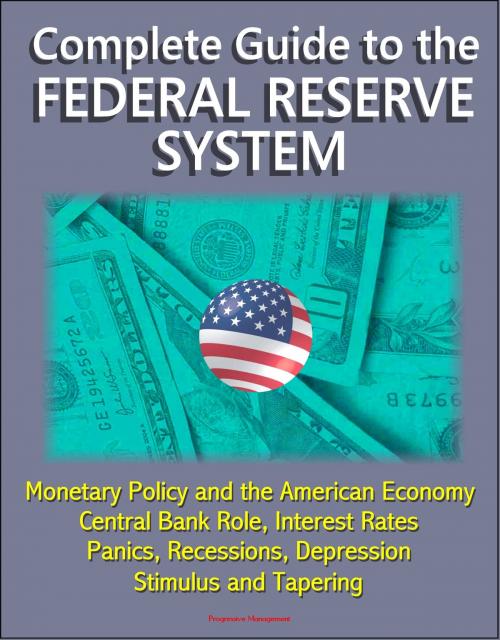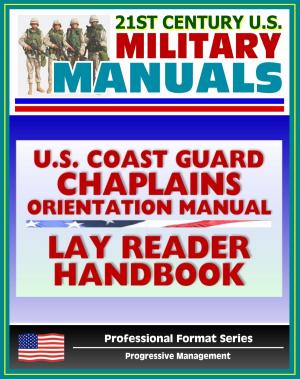Complete Guide to the Federal Reserve System: Monetary Policy and the American Economy, Central Bank Role, Interest Rates, Panics, Recessions, Depression, Stimulus and Tapering
Business & Finance, Economics, Money & Monetary Policy| Author: | Progressive Management | ISBN: | 9781301529605 |
| Publisher: | Progressive Management | Publication: | August 21, 2013 |
| Imprint: | Smashwords Edition | Language: | English |
| Author: | Progressive Management |
| ISBN: | 9781301529605 |
| Publisher: | Progressive Management |
| Publication: | August 21, 2013 |
| Imprint: | Smashwords Edition |
| Language: | English |
This unique ebook provides a comprehensive guide to the Federal Reserve System, with up-to-date information on monetary policy, the role and history of the Fed, causes of financial panics, recessions, and depressions - including the 2007-2008 financial crisis - and current debates about stimulus and tapering. There are four parts to this massive compilation:
Part 1: Frequently Asked Questions and Recent Statements about the Federal Reserve and Monetary Policy - Why do the U.S. economic recovery and labor market require ongoing monetary policy support through the purchase of longer-term Treasury securities and agency mortgage-backed securities? What are the Federal Reserve's large-scale asset purchases? Monetary Policy since the Onset of the Crisis. Making Policy with Nontraditional Tools: A Cost-Benefit Framework. How will the Federal Reserve ensure that the size of its balance sheet won’t lead to excessive inflation? What are the Federal Reserve's objectives in conducting monetary policy?
Part 2: The Federal Reserve System: Purposes and Functions - Overview of the Federal Reserve System * Monetary Policy and the Economy * Goals of Monetary Policy * How Monetary Policy Affects the Economy * Limitations of Monetary Policy * Guides to Monetary Policy * Monetary Aggregates * Interest Rates * The Taylor Rule * Foreign Exchange Rates * The Implementation of Monetary Policy * The Market for Federal Reserve Balances * Demand for Federal Reserve Balances * Supply of Federal Reserve Balances * Controlling the Federal Funds Rate * Open Market Operations * The Federal Reserve in the International Sphere * Supervision and Regulation * Consumer and Community Affairs * The Federal Reserve in the U.S. Payments System
Part 3: Roles and Responsibilities of Federal Reserve Directors - Introduction to the Federal Reserve System * Structure of the Federal Reserve System * A Decentralized System * A Blend of Private and Governmental Characteristics * Functions and Responsibilities of the Federal Reserve System * Monetary Policy * Financial System Stability * Supervision and Regulation * Financial Services * Consumer Affairs * Federal Reserve System Boards of Directors * Selection Criteria * Affiliation and Stockholding Provisions * Reporting Requirements and Divestiture * Term Limits and Rotation Policy * Board Leadership * Roles and Responsibilities of Directors * Formulation of Monetary and Credit Policy * Connecting the Federal Reserve and the Private Sector * Corporate Governance * Responsibilities of Head-Office Directors * Director Conferences and Programs * Director Conduct * Ethical Standards * Policy on Political Activity.
Part 4: The Federal Reserve and the Financial Crisis - Lectures - In March 2012, Chairman Ben S. Bernanke delivered a four-part lecture series about the Federal Reserve and the financial crisis that emerged in 2007. The series began with a lecture on the origins and missions of central banks, followed by a lecture that discussed the role and actions of the Federal Reserve in the period after World War II. In the final two lectures, the Chairman reviewed some of the causes of, and policy responses to, the recent financial crisis, focusing specifically on the actions of the Federal Reserve. Lecture 1: Origins and Mission of the Federal Reserve * Lecture 2: The Federal Reserve after World War II * Lecture 3: The Federal Reserve's Response to the Financial Crisis * Lecture 4: The Aftermath of the Crisis. These lectures review some of the causes of and policy responses to the recent financial crisis, focusing on the role of the Federal Reserve. Understanding the role of the Federal Reserve in the recent financial crisis requires an understanding of the origins and mission of central banks; the lessons of previous financial crises and how they informed the Fed's decisions in the recent one.
This unique ebook provides a comprehensive guide to the Federal Reserve System, with up-to-date information on monetary policy, the role and history of the Fed, causes of financial panics, recessions, and depressions - including the 2007-2008 financial crisis - and current debates about stimulus and tapering. There are four parts to this massive compilation:
Part 1: Frequently Asked Questions and Recent Statements about the Federal Reserve and Monetary Policy - Why do the U.S. economic recovery and labor market require ongoing monetary policy support through the purchase of longer-term Treasury securities and agency mortgage-backed securities? What are the Federal Reserve's large-scale asset purchases? Monetary Policy since the Onset of the Crisis. Making Policy with Nontraditional Tools: A Cost-Benefit Framework. How will the Federal Reserve ensure that the size of its balance sheet won’t lead to excessive inflation? What are the Federal Reserve's objectives in conducting monetary policy?
Part 2: The Federal Reserve System: Purposes and Functions - Overview of the Federal Reserve System * Monetary Policy and the Economy * Goals of Monetary Policy * How Monetary Policy Affects the Economy * Limitations of Monetary Policy * Guides to Monetary Policy * Monetary Aggregates * Interest Rates * The Taylor Rule * Foreign Exchange Rates * The Implementation of Monetary Policy * The Market for Federal Reserve Balances * Demand for Federal Reserve Balances * Supply of Federal Reserve Balances * Controlling the Federal Funds Rate * Open Market Operations * The Federal Reserve in the International Sphere * Supervision and Regulation * Consumer and Community Affairs * The Federal Reserve in the U.S. Payments System
Part 3: Roles and Responsibilities of Federal Reserve Directors - Introduction to the Federal Reserve System * Structure of the Federal Reserve System * A Decentralized System * A Blend of Private and Governmental Characteristics * Functions and Responsibilities of the Federal Reserve System * Monetary Policy * Financial System Stability * Supervision and Regulation * Financial Services * Consumer Affairs * Federal Reserve System Boards of Directors * Selection Criteria * Affiliation and Stockholding Provisions * Reporting Requirements and Divestiture * Term Limits and Rotation Policy * Board Leadership * Roles and Responsibilities of Directors * Formulation of Monetary and Credit Policy * Connecting the Federal Reserve and the Private Sector * Corporate Governance * Responsibilities of Head-Office Directors * Director Conferences and Programs * Director Conduct * Ethical Standards * Policy on Political Activity.
Part 4: The Federal Reserve and the Financial Crisis - Lectures - In March 2012, Chairman Ben S. Bernanke delivered a four-part lecture series about the Federal Reserve and the financial crisis that emerged in 2007. The series began with a lecture on the origins and missions of central banks, followed by a lecture that discussed the role and actions of the Federal Reserve in the period after World War II. In the final two lectures, the Chairman reviewed some of the causes of, and policy responses to, the recent financial crisis, focusing specifically on the actions of the Federal Reserve. Lecture 1: Origins and Mission of the Federal Reserve * Lecture 2: The Federal Reserve after World War II * Lecture 3: The Federal Reserve's Response to the Financial Crisis * Lecture 4: The Aftermath of the Crisis. These lectures review some of the causes of and policy responses to the recent financial crisis, focusing on the role of the Federal Reserve. Understanding the role of the Federal Reserve in the recent financial crisis requires an understanding of the origins and mission of central banks; the lessons of previous financial crises and how they informed the Fed's decisions in the recent one.















